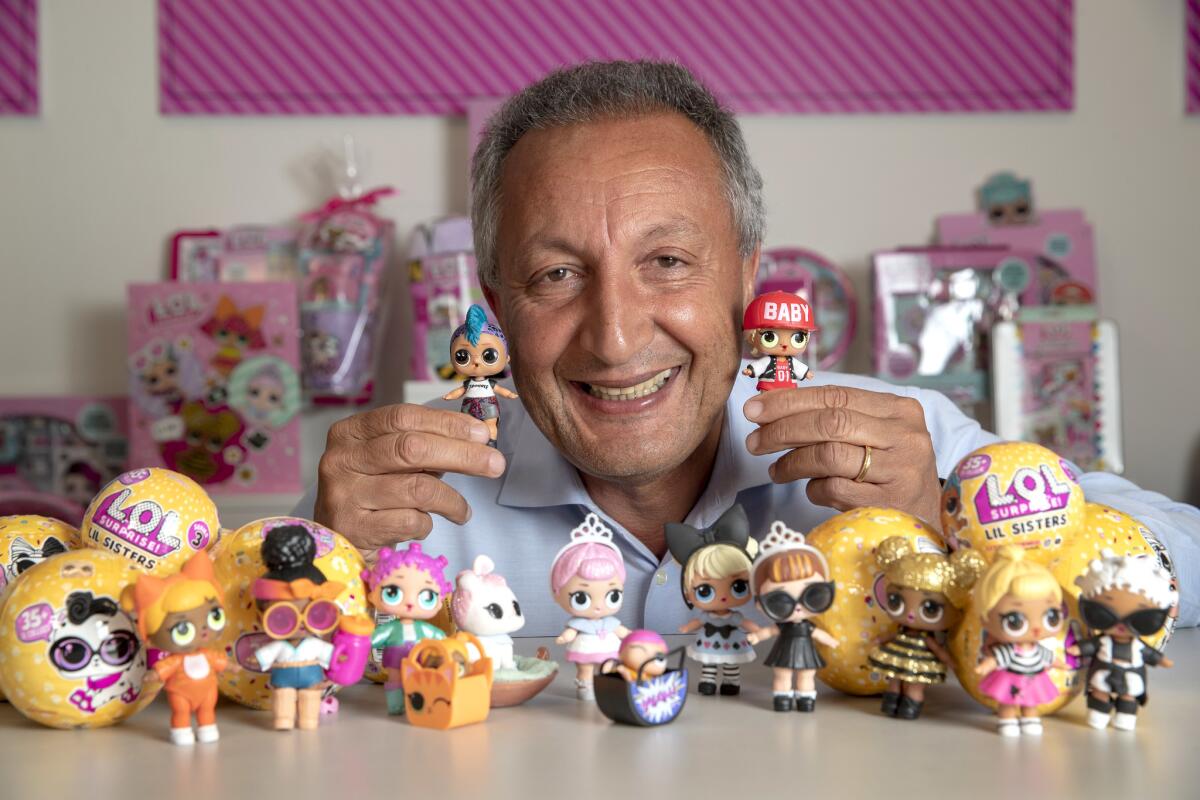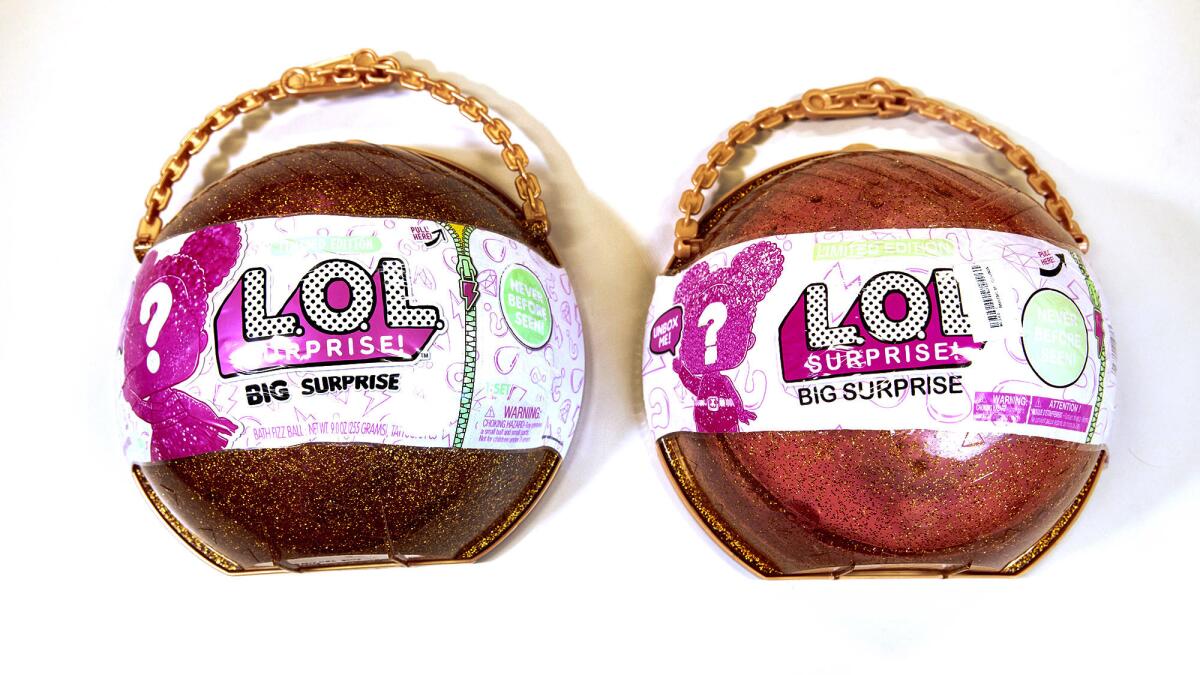America’s most popular doll is being counterfeited. L.A. toymaker MGA wants to know who’s doing it

- Share via
Earlier this year, attorney Jennifer Marrow visited TomTop.com, an online marketplace, to buy one of the most popular toys in America.
The site based in China claimed it had a deal on the priciest version: the limited-edition L.O.L Surprise! Big Surprise, a rose-gold case with 50 small toys, including dolls, miniature outfits, accessories and stickers. The price was only $79.99, a steal for the hard-to-find item, which sold on some third-party websites for multiple times its $69.99 list price.
But Marrow wasn’t buying a gift. She was ordering evidence.
What TomTop didn’t know was that it mailed the package to Marrow’s office at MGA Entertainment, the Van Nuys company that created, patented and trademarked L.O.L Surprise! dolls. Inside, Marrow found a product claiming to be a Big Surprise, but with clear indications it was counterfeit: The color was off, the label had mistakes and the materials were inferior, according to court records.
The real surprise would come later, when MGA filed a lawsuit in March in U.S. District Court in Los Angeles, arguing that TomTop knowingly sold the bogus dolls to unsuspecting customers.
“Once a toy becomes hot, the Chinese counterfeiters focus on that, and they quickly knock it off and bring it to the market,” said MGA founder and Chief Executive Isaac Larian. “What I haven’t seen until now is how openly blatant they are about it.”
Established in 2004, TomTop is a wholesale and retail online shopping site headquartered in the southern Chinese city of Shenzhen. Neither TomTop nor its attorneys responded to multiple emails and calls requesting comment.
However, in response to MGA’s lawsuit, TomTop has argued in court records that it “has never sold, offered for sale, used, imported, distributed or marketed any product or work” of MGA.

L.O.L. Surprise! dolls are ball-shaped toys with five to nine layers to unwrap.
MGA says the case highlights an issue many U.S. toy companies are facing: China-based websites that advertise discounted versions of sought-after toys, when the sites are really schlepping cheaply made counterfeits or knockoffs, slightly altered versions that still amount to a theft of intellectual property.
Last September, customs officers seized 3,004 counterfeit Barbie dolls at the Canadian border in Minnesota, and made a similar bust in June, netting 60,180 mermaid and fashion dolls. In December, Lego Group won its suit against two Chinese companies making and selling counterfeit Bela blocks.
At this year’s American International Toy Fair in New York, the largest annual industry gathering in the Western Hemisphere, two issues were on the minds of many companies: the looming closure of Toys R Us and the sale of counterfeit toys.
“People were managing their concerns about Toys R Us, but there was huge, huge outcry that we all have to come together against counterfeiting,” said Steve Pasierb, chief executive of the Toy Assn., which organizes the event.
Figures from U.S. Customs and Border Protection show that toy seizures fluctuate year by year.
In 2011, the agency seized 495 shipments of counterfeits, with a list-price value of $26 million. Two years later, agents made 175 seizures, the lowest number in about a decade. Since then, though, seizures have climbed back up, with agents making 449 seizures, valued at $12 million, in 2017.
But it’s likely that the number of bogus toys that make it to U.S. shores is much higher than that.
As trade between the U.S. and China has risen sharply — imports soared 60% to nearly half a trillion dollars in the 10 years leading up to 2016 — counterfeiters have taken advantage of an overloaded system, operating much like drug cartels.

Counterfeiters send their products through in multiple shipments, sometimes filling a container with both legitimate and counterfeit products. Last July, officers at the Charleston, S.C., seaport found counterfeit Power Rangers and James Bond characters in a shipment from China, destined for a North Carolina-based importer. Of the 284 cartons of toys in the shipment, 27 contained 34,690 counterfeits.
The counterfeiters leverage the fact that customs officers don’t have the capacity to stop every shipment entering a U.S. port of entry.
“If we stop every single container, the economy would collapse tomorrow,” said customs spokesman Jaime Ruiz.
To get customs officers to check a specific container suspected of containing counterfeits, companies typically must hire private investigators to ferret out the tracking number.
“It’s very difficult for the company to successfully get that information unless they can really infiltrate into the counterfeiting chain, which is really hard to do,” said Daniel Chow, an Ohio State University professor who has testified before the U.S. International Trade Commission about Chinese intellectual property infringements.
Instead, many companies take the legal route like MGA, which has been aggressive in trying to protect the sales of its L.O.L. Surprise! dolls — but so far with limited success.
Premiering in October 2016, the toy line has been an unexpected hit for MGA, which also makes the popular line of sassy, pouty-lipped Bratz dolls.
Once a toy becomes hot, the Chinese counterfeiters focus on that, and they quickly knock it off and bring it to the market.
— MGA founder and Chief Executive Isaac Larian
L.O.L. Surprise! dolls are ball-shaped toys with five to nine layers to unwrap. Each layer comes with its own surprise, and inside the ball, there’s a small, wide-eyed plastic doll. The toys range in price from $6.99 for L.O.L Surprise! Lil Sisters to $12.99 for L.O.L. Surprise! Confetti Pop. The toy is also sold in packages of multiple dolls and accessories, such as the $29.99 L.O.L. Pearl Surprise and the $69.99 Big Surprise.
The doll was the top-selling toy of 2017 in the U.S., U.K. and Canada, and continues to be a top seller this year, according to market research company NPD Group. (Neither NPD nor privately held MGA release units sold.)
Online, the dolls have a substantial following, with the L.O.L. Surprise! YouTube channel amassing more than 500,000 followers and almost 162 million views since late 2016.
Even Larian, whose Bratz dolls ate into Barbie sales when they premiered in the early 2000s, says he has been surprised at its success.
“In 40 years, I’ve literally never seen something like this,” he said.
That has led to loads of counterfeits and MGA’s aggressive pursuit of them.
In April, MGA was granted a default judgment of $1.2 million and a permanent injunction against 81 sellers hawking fake dolls online, including on Alibaba, AliExpress and DHGate, China-based online retail platforms. A court ordered that PayPal and Alipay turn over money from the sellers’ accounts to MGA.
TomTop was MGA’s next target.
The online retailer has been sued by other manufacturers, including in 2016 over cables with counterfeit trademarked HDMI logos and another time that year by Cree, an LED light manufacturer, for selling “pirated and counterfeit” versions of its products, court records show. Cree won a permanent injunction against TomTop, while the HDMI case entered into settlement talks, according to court records.
TomTop describes itself as a “reliable wholesale and retail online shop” that offers more than 1 million products, including clothing, toys and cellphones.
The site promotes positive reviews via an affiliate program that offers a commission to members who recommend TomTop on social media. The site’s tagline is: “Loving. Shopping. Sharing.”
Online, users appear to either love or hate the site — writing, via Google reviews, glowing five-star ratings that celebrate the low prices, or one-star reviews that ding TomTop for low-quality products and poor customer service.
Rachel Jones is chief executive of SnapDragon, an Edinburgh, Scotland-based legal tech firm that helps companies track and shut down online retailers selling fake products.
Jones said although TomTop sells a lot of unbranded products, it also offers those that appear to infringe on companies’ design rights — yet doesn’t offer a way to report them with ease. She notes it also has worked hard to burnish its reputation with its affiliate program.
“They have successfully managed to get 1.3 million likes for their Facebook page. Nonetheless if you look at other websites, you can find many negative reviews complaining about invalid tracking numbers, low-quality products and awful customer service,” she said in an email.
One reviewer identified as a customer wrote on Trustpilot: “Everything they sell is fake, fake, fake. They advertise with the picture of the original and they send you an awful, awful fake. Their excuse is: ‘We never advertise them as original.’ But they didn’t mention they are copies either. So they just get away with that, even if pics show original products.”
If we stop every container, the economy would collapse tomorrow.
— U.S. Customs and Border Protection spokesman Jaime Ruiz
MGA’s case against TomTop includes one element that counterfeit and intellectual property cases often don’t have: Unlike most China-based websites, TomTop has a warehouse in the United States.
Located in Industry, the large warehouse and small attached office cut a low profile. The only sign for the business is a piece of paper, taped to the glass on the front door, welcoming guests and requesting they make an appointment.
When a Times reporter went to TomTop’s office — after receiving no response to several attempts to schedule an interview with TomTop’s CEO or attorneys — staff allowed the reporter inside. The lights to the lobby were off. No one was working the front desk. The office space was largely bare, with one large room with a shelf holding a handful of drones. The warehouse appeared to have several boxes inside.
After 15 minutes, the reporter was asked to leave after staff decided it best to decline to comment, requesting instead she talk to Mark Fang, TomTop’s Los Angeles-area attorney. Fang did not return calls for comment.
Until at least late February, TomTop.com listed the Industry address, 14273 E. Don Julian Road, on its “Contact Us” page, according to the internet archive tool the Wayback Machine. TomTop has since removed the California address from its site.
One legal wrinkle for MGA is that it is suing both the Shenzhen-based TomTop Technology Group and TomTop Group Ltd., based at the Industry warehouse.
MGA attorneys have argued the two entities are one and the same. However, attorneys for the two groups have fired back that the TomTop office in Industry is used solely for shipping sealed products sent from China and for returns, and that no product is sold by the U.S. arm of the company.
In March, a private investigator hired by MGA went to TomTop’s Industry office, and while there, took photographs of a TomTop employee seated next to an L.O.L. Surprise! box. MGA hoped this would be enough to prove that TomTop had counterfeit L.O.L. Surprise! dolls at its Industry warehouse.
But, in court, it was unsuccessful. About two weeks later, a judge denied MGA’s request for a temporary restraining order against TomTop, asserting that MGA’s attorneys failed to provide enough evidence that the U.S.-based TomTop entity was using the warehouse to sell counterfeit L.O.L. Surprise! dolls.
“The box photographed at TomTop’s warehouse does appear to be an accused product,” the judge wrote. “However, the presence of a single box at a warehouse that processes returns for another company is insufficient evidence that TomTop is selling infringing products.”
The case is still playing out in court as counterfeiters continue cutting into MGA’s profits.
MGA told The Times last month that there were again fake L.O.L. Surprise! dolls for sale on Alibaba, AliExpress and DHGate.
DHGate did not respond to a request for comment, but a spokesman for Alibaba Group, which owns Alibaba and AliExpress, said the company has stepped up its effort to battle counterfeits. In 2017, Alibaba processed 95% of notice and takedown requests from rights holders within 24 hours, a 65% reduction in processing time when compared with 2016, according to the company.
Still, copyright infringement lawsuits remain one of the better options for MGA until it can find the actual manufacturer of the counterfeit dolls.
Larian, MGA’s CEO, said authorized licensees have become so frustrated that they have questioned why they should buy authentic L.O.L. Surprise! dolls when the counterfeit products are cheaper.
In South Korea, for example, counterfeit L.O.L. Surprise! dolls have flooded the market so much that MGA has seen its sales drop by half in recent months, Larian said. The fake dolls have even sprouted up at discount stores in Los Angeles, including at a dollar store in Koreatown.
And so, for the last six months, MGA has taken to social media to remind customers of how to spot a fake L.O.L. Surprise! doll.

Using hashtags on Instagram such as #BlockOutTheFakers and #nocopycats, MGA has created videos featuring child actors Tahani and Mykal-Michelle. “Now, here are the real L.O.L. Surprise! balls,” Tahani, 15, says, moving her hands. “Here are the fake ones. Can you tell the difference?” Mykal-Michelle, 6, is quick to respond: “Uh, duh.”
In some industries, including toys, auto parts and high-priced sneakers, a company’s suppliers might make extra product that they sell on the black market, according to researchers for the Organisation for Economic Co-operation and Development.
MGA’s attorneys say that’s not their problem. L.O.L. Surprise! dolls are made in seven factories in China, and the company says it works closely with them to safeguard its supply chain.
Instead, they suspect, counterfeiters working out of shoddy factories are the problem, using low-quality and sometimes dangerous and flammable materials to manufacture fake dolls.
Earlier this year, the European Commission, an arm of the European Union, sent out a safety alert about knockoff L.O.L. Surprise! dolls shipped from China that Czech Republic officials found at the border.
The plastic dolls contained a chemical – bis(2-ethylhexyl) phthalate, or DEHP – a phthalate that “may harm the health of children, causing possible damage to the reproductive system,” the notice read.
Benjamin Jonson, an attorney at MGA, said the company is on a mission to find out who is making the dolls.
“If it’s not TomTop themselves manufacturing, we can find out who it is, and hopefully rip the snake’s head off at the source,” he said.
More to Read
Inside the business of entertainment
The Wide Shot brings you news, analysis and insights on everything from streaming wars to production — and what it all means for the future.
You may occasionally receive promotional content from the Los Angeles Times.











